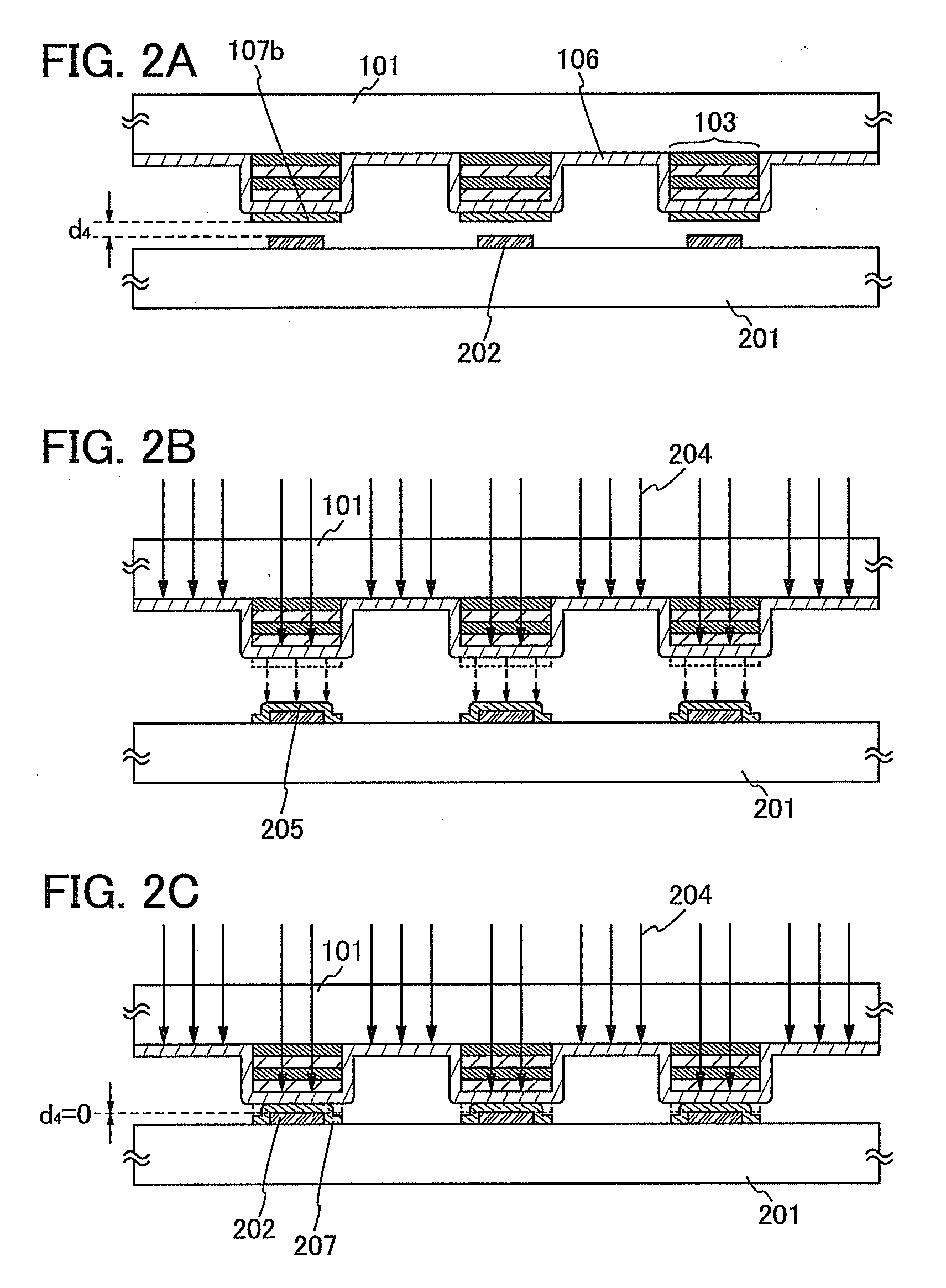Method for manufacturing light-emitting device
a technology of light-emitting devices and manufacturing methods, which is applied in the direction of solid-state devices, vacuum evaporation coatings, coatings, etc., can solve the problems of high probability of decomposition or deterioration of the material which forms the transfer layer, high probability of high uneven transfer film formation, and low film quality. , to achieve the effect of high light-emitting characteristics, high accuracy and high definition
- Summary
- Abstract
- Description
- Claims
- Application Information
AI Technical Summary
Benefits of technology
Problems solved by technology
Method used
Image
Examples
embodiment 1
[0042]In Embodiment 1, a deposition method using an evaporation donor substrate according to an embodiment of the present invention is described. Note that the case where an EL layer of a light-emitting element is formed using an evaporation donor substrate over which an evaporation material is patterned will be described in Embodiment 1.
[0043]An evaporation donor substrate used in this embodiment is described with reference to FIGS. 1A to 1D. As illustrated in FIG. 1A, a function layer 103 having opening portions 102 is formed over a first substrate 101 which is a supporting substrate. Note that the function layer 103 has a structure in which high-refractive index films 104 formed with a material having a high refractive index and low-refractive index films 105 formed with a material having a low refractive index are alternately stacked. Note that the function layer 103 has a structure in which two or more high-refractive index films 104 (104a, 104b) and two or more low-refractive ...
embodiment 2
[0090]In this embodiment, in a deposition method using an evaporation donor substrate according to an embodiment of the present invention, an apparatus is described which is used in the case where an evaporation donor substrate is irradiated with laser light as the first light.
[0091]FIG. 4 is a perspective view illustrating an example of an apparatus using laser light. Laser light is outputted from a laser 403 (a YAG laser device, an excimer laser device, or the like) and transmitted through a first optical system 404 for changing a laser beam shape into a rectangular shape, a second optical system 405 for shaping the laser beam, and a third optical system 406 for collimating the laser beam; and an optical path is bent in a direction perpendicular to a first substrate 401, which is an evaporation donor substrate, over a first substrate stage 409 by using a reflecting mirror 407. Then, the first substrate 401 is irradiated with the laser beam.
[0092]Note that a structure of the evapor...
embodiment 3
[0101]In this embodiment, in a deposition method using an evaporation donor substrate according to an embodiment of the present invention, an apparatus which is used in the case where an evaporation donor substrate including a material layer which is patterned is irradiated with lamp light as the second light is described.
[0102]In FIG. 5A, a deposition chamber 501 is a vacuum chamber and is connected to another chamber via a gate valve 502. Further, the deposition chamber 501 is provided with an exhaust mechanism 503. In addition, in the deposition chamber 501, at least a substrate stage 504 for holding a first substrate 511 (including material layers 513) which is an evaporation donor substrate, substrate supporting units 505 for holding a third substrate 512 which is a deposition target substrate, and light sources 510 are provided.
[0103]Note that, over the first substrate 511 which is held by the substrate stage 504, the material layer is patterned by performing treatment shown i...
PUM
| Property | Measurement | Unit |
|---|---|---|
| refractive index | aaaaa | aaaaa |
| refractive index | aaaaa | aaaaa |
| reflectance | aaaaa | aaaaa |
Abstract
Description
Claims
Application Information
 Login to View More
Login to View More - Generate Ideas
- Intellectual Property
- Life Sciences
- Materials
- Tech Scout
- Unparalleled Data Quality
- Higher Quality Content
- 60% Fewer Hallucinations
Browse by: Latest US Patents, China's latest patents, Technical Efficacy Thesaurus, Application Domain, Technology Topic, Popular Technical Reports.
© 2025 PatSnap. All rights reserved.Legal|Privacy policy|Modern Slavery Act Transparency Statement|Sitemap|About US| Contact US: help@patsnap.com



